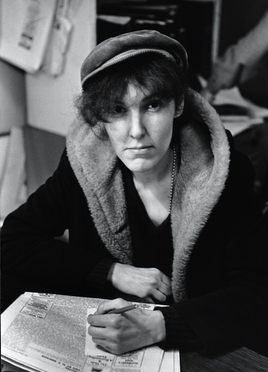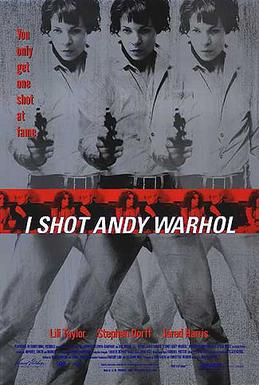Related Research Articles

Andy Warhol was an American visual artist, film director, producer, and leading figure in the pop art movement. His works explore the relationship between artistic expression, advertising, and celebrity culture that flourished by the 1960s, and span a variety of media, including painting, silkscreening, photography, film, and sculpture. Some of his best-known works include the silkscreen paintings Campbell's Soup Cans (1962) and Marilyn Diptych (1962), the experimental films Empire (1964) and Chelsea Girls (1966), and the multimedia events known as the Exploding Plastic Inevitable (1966–67).

Valerie Jean Solanas was an American radical feminist known for the SCUM Manifesto, which she self-published in 1967, and for her attempt to murder artist Andy Warhol in 1968.

I Shot Andy Warhol is a 1996 biographical drama film about the life of Valerie Solanas and her relationship with the artist Andy Warhol. The film marked the feature film directorial debut of Canadian director Mary Harron. The film stars Lili Taylor as Valerie, Jared Harris as Andy Warhol, and Martha Plimpton as Valerie's friend Stevie. Stephen Dorff plays Warhol superstar Candy Darling. John Cale of The Velvet Underground wrote the film's score despite protests from former band member Lou Reed. Yo La Tengo plays an anonymous band that is somewhat reminiscent of the group.
Warhol superstars were a clique of New York City personalities promoted by the pop artist Andy Warhol during the 1960s and early 1970s. These personalities appeared in Warhol's artworks and accompanied him in his social life, epitomizing his dictum, "In the future everyone will be famous for fifteen minutes". Warhol would simply film them, and declare them "superstars".

Mary Harron is a Canadian film director and screenwriter. She wrote and directed several independent films, including I Shot Andy Warhol (1996), American Psycho (2000), and The Notorious Bettie Page (2005). She co-wrote American Psycho and The Notorious Bettie Page with Guinevere Turner.

The Factory was Andy Warhol's studio in New York City, which had four locations between 1963 and 1987. The Factory became famed for its parties in the 1960s. It was the hip hangout spot for artists, musicians, celebrities and Warhol's superstars. The original Factory was often referred to as the Silver Factory. In the studio, Warhol's workers would make silkscreens and lithographs under his direction.

Empire is a 1965 American black-and-white silent art film by Andy Warhol. When projected according to Warhol's specifications, it consists of eight hours and five minutes of slow motion footage of an unchanging view of New York City's Empire State Building. The film does not have conventional narrative or characters, and largely reduces the experience of cinema to the passing of time. Warhol stated that the purpose of the film was "to see time go by."

Factory Girl is a 2006 American biographical film directed by George Hickenlooper. It is based on the rapid rise and fall of 1960s underground film star and socialite Edie Sedgwick, known for her association with the artist Andy Warhol.
Viva is an American actress, writer and former Warhol superstar.

Lonesome Cowboys is a 1968 American Western film directed by Andy Warhol and written and produced by Paul Morrissey. The film is a satire of Hollywood Westerns, and was initially screened in November 1968 at the San Francisco International Film Festival, where it won the Best Film Award. On May 5, 1969, it was shown for initial viewings at the New Andy Warhol Garrick Theatre in New York City.
I, a Man is a 1967 American erotic drama film written, directed and filmed by Andy Warhol. It debuted at the Hudson Theatre in New York City on August 25, 1967. The film depicts the main character, played by Tom Baker, in a series of sexual encounters with eight women. Warhol created the movie as a response to the popular erotic Scandinavian film I, a Woman, which had opened in the United States in October 1966.

Isabelle Collin Dufresne, known professionally as Ultra Violet, was a French-American artist, author, and both a colleague of Andy Warhol and one of his so-called Superstars. Earlier in her career, she worked for and studied with surrealist artist Salvador Dalí. Dufresne lived and worked in New York City, and also had a studio in Nice, France.
Sleep is a 1964 American avant-garde film by Andy Warhol. Lasting five hours and 21 minutes, it consists of looped footage of John Giorno, Warhol's lover at the time, sleeping.

Shot Marilyns is a series of silkscreen paintings produced in 1964 by Andy Warhol, each canvas measuring 40 inches square, and each a portrait of Marilyn Monroe.

The Decker Building is a commercial building located at 33 Union Square West in Manhattan, New York City. The structure was completed in 1892 for the Decker Brothers piano company, and designed by John H. Edelmann. From 1968 to 1973, it served as the location of the artist Andy Warhol's studio, The Factory. The Decker Building was designated a New York City landmark in 1988, and was added to the National Register of Historic Places in 2003.
Frederick or Fred Hughes may refer to:
San Diego Surf is a 1968 feature film directed by Andy Warhol and Paul Morrissey, and filmed in La Jolla, California in May 1968. On June 3, 1968, Warhol was shot by Valerie Solanas, bringing work on the film to a halt. In 1996, the Andy Warhol Foundation commissioned Morrissey to "finish editing the film based on Warhol's notes".
Margo Feiden was the proprietor of Margo Feiden Galleries Ltd. located at 15 East 9th Street in New York City. She was also a producer, director, author, and playwright.

Orange Prince(1984) is a painting by American artist Andy Warhol, of Prince, the American singer, songwriter, record producer, multi-instrumentalist, actor, and director. The painting is one of twelve silkscreen portraits on canvas of Prince created by Warhol in 1984, based on an original photograph provided to Warhol by Vanity Fair. The photograph was taken by Lynn Goldsmith. These paintings and four additional works on paper are collectively known as the Prince Series. Each painting is unique and can be distinguished by colour.
"Andy's Chest" is a song written by Lou Reed, inspired by the 1968 attempt on Andy Warhol's life. In June 1968, radical feminist writer Valerie Solanas shot Warhol and Mario Amaya, art critic and curator, at Warhol's studio.
References
- ↑ "A Farewell to Dapper Fred Hughes: He Oversaw Andy's Factory Empire". The New York Observer . 29 January 2001.
- ↑ "I could have saved Andy Warhol from being shot". 2 June 2018.
- ↑ DiGiacomo, Frank (29 January 2001). "A Farewell to Dapper Fred Hughes: He Oversaw Andy's Factory Empire". Observer.
- ↑ Vogel, Carol (16 January 2001). "Frederick Hughes, Collector and Warhol's Manager, 57". The New York Times.
- ↑ "The House That Fred Built | Vanity Fair | August 1993".